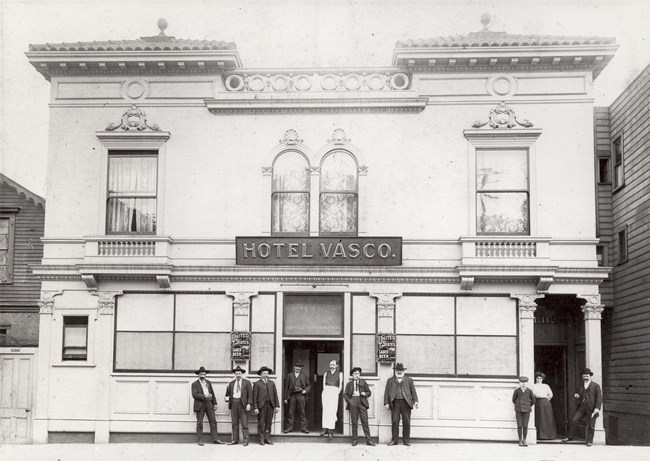Part of a series of articles titled Women's History in the Pacific West - California-Great Basin Collection.
Previous: Julia Ann Shelton Shorey
Next: Betty Reid Soskin
Article

Basque Hotel in San Francisco—Hotel Vasco, John Bilbao Basque Library Collections, Special Collections and University Archives Department, University of Nevada, Reno.
The image of the solitary Basque sheepherder passing through the Sierra Nevada presents only a partial picture of the complex social, economic, and family ties that bound the Basque community in California. While the men literally left their mark on the land through the drawings and glyphs they carved in what is now Devils Postpile National Monument, Basque women left their mark by providing cultural and social gathering sites for their communities. They did this largely through running Basque boardinghouses called ostatuaks. These boardinghouses were significant links in the social and economic chains that brought men to Devils Postpile Monument. Martina Aguirre was one of the first of these boardinghouse owners.
Aguirre was born Maria Martina Labayon in 1817 in Areso, Spain where she was surrounded by a Basque culture and language that was separate from the predominantly Spanish culture to the south.1 At some point, she moved to Montevideo, Uruguay, possibly to escape the tumultuous upheaval of the First Carlist War in Northern Spain’s Basque communities. There she married another Basque immigrant, Juan Miguel Aguirre, and, when they heard that gold had been found in California, they sailed together to San Francisco in 1849.2
In their new home, Aguirre’s husband began carting water from wells throughout the city and selling it for a dollar a bucket. Soon the Aguirres had enough money to invest in real estate and opened a boardinghouse on Powell Street that was officially called Hotel Vasco but informally called the Aguirre Hotel.3 This ostatuak catered mostly to the small but tightknit group of Basque immigrants who began trickling into California.
The majority of these Basque immigrants were young, poor, and unmarried men, and Aguirre’s ostatuak became their cultural and domestic center.4 Aguirre cooked traditional Basque meals for her boarders, tended to their rooms, and communicated with them in the Basque language. Her husband built the first Basque handball court in San Francisco where boarders could play their traditional sport, and promoted the construction of a Catholic church where they could worship in their language.5 At the ostatuak, Basque boarders could maintain connections to their traditions and sense of cultural identity.
Aguirre’s ostatuak was also an important part of the economic networks that brought Basque men into the Eastern Sierra Nevada and past Devils Postpile. The Basque sheepherders may have seemed like isolated and nomadic men during their summer herding, but they were dependent on the contacts made at Aguirre’s ostatuak to find work. Italian farmer Alberto Trescany often came to Aguirre’s ostatuak to hire Basque sheepherders to pasture his sheep in the mountains. He was not the only one. As one local history recounted, “There was a Basque hotel in the center of town [the Hotel Vasco], where California rancheros in need of help were sure to find quiet gentle men from the Pyrenees.”6
Aguirre’s ostatuak was also a place for Basque herders to leave their mountain isolation and return to socialize with other Basque men and women. This is how many Basque Californians met their spouses. Aguirre’s family, especially the female members of her family, became important links in these social networks. For example, Juan Miguel Arburua met Aguirre’s niece, Josefa Labayon, at the ostatuak after she came from Spain to help Aguirre with boardinghouse chores. In 1898, Francisca Arriola met her future husband Saturnio Celayeta at the Aguirres’ shortly after immigrating to San Francisco. Even Aguirre’s daughter, Kate, met her husband at the ostatuak when he came to hire Basque sheepherders.7
In addition to running the ostatuak, Aguirre and her husband raised four children who become translators, candymakers, and boardinghouse owners themselves.8 Her husband died in 1897, and Aguirre continued to run the ostatuak herself until her death a year later.9 During her lifetime, her boardinghouse served as a social center for the Basque population in California. Her work influenced many Basque men and women who spread out from San Francisco to the Sierra Nevada and beyond. Glimpses of the ways people in the past used the terrain at Devils Postpile are possible in faint sheep trails and names carved on Aspen trunks.10 Understanding the economic and social world that undergirded these traces requires knowing the history of women like Aguirre who did the essential labor of maintaining the link between city and mountain range.
Part of a series of articles titled Women's History in the Pacific West - California-Great Basin Collection.
Previous: Julia Ann Shelton Shorey
Next: Betty Reid Soskin
Last updated: February 22, 2022